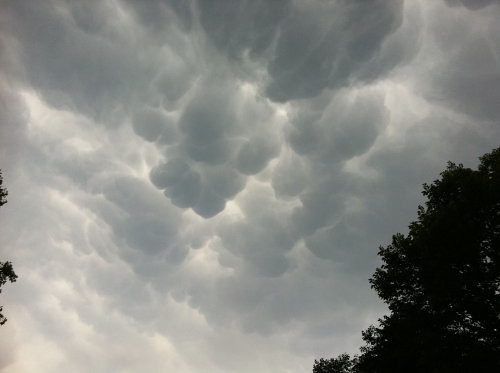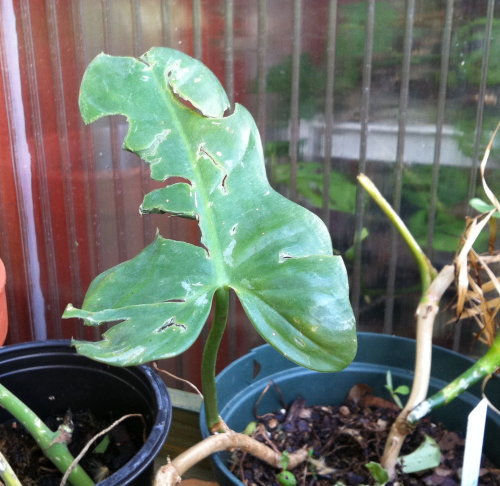Over the last couple of years, our quiet little college town of Norman, Oklahoma has been hit with the full spectrum of natural (non-major) disasters. Last year we had several
wildfires that really scared some residents (who fortunately only lost trees, grass and a couple of fences). We've had 3
tornadoes within city limits in the last 3 years (2 of them fatal). We had an
earthquake measuring somewhere between 4.3 and 5.1 on the Richter scale. We've had flash flooding and three pretty substantial snowstorms, including one on
Christmas Eve. We had an
ice storm that mangled all of our trees and knocked out electricity for most of Norman for a couple of days.
 |
| Angry mammatus clouds, just 30 minutes before the madness ensued. |
Lately it's been really hot (>100F) and dry (actually kind of humid, but no precipitation). Literally out of the blue, a storm formed just a county west of us last Tuesday (
June 14) in the early evening. It quickly turned into a beast and dumped some really heavy rain and hail on Norman. When one of these storms creates a strong surge of precipitation and air towards the ground, it is called a downburst (or microburst). When all of this momentum hits the ground, it spreads out, creating very strong horizontal winds. In this case there were measured winds in excess of 70 miles per hour. There are likely locations without wind gauges which had speeds around 90 mph.
 |
| Norman microburst June 14, 2011. This is the best picture I captured with my iPhone during the event. |
This microburst in Norman caused lots of houses to have shingle damage, downed fences, broken windows, battered trees and associated damage. My sister's chimney blew off their house. Some people who don't understand the physics behind this process claim there had to have been a tornado to cause the damage they see, but it was definitely a downburst.
 |
| Philodendron cordatum with holes punched in the leaves. Those are not natural fenestrations. |
For the last couple of weeks my poor plants have been requesting a little drop of rain. What they got instead was about 10 minutes of crazy wind and a pelting from marble to golf ball sized hail stones. The more fortunate (top heavy) plants tipped over quickly and were laying on the ground in somewhat of a sheltered position. The other plants really took a beating. To give you an idea of the storm, watch
this video. Here's
another. Since Norman is a town full of weather nerds, you can find plenty of videos and photos, if you search "Norman June 14 microburst".
 |
| Philodendron bipennifolium with holes punched in the leaves. |
Many of my plants with "tougher" leaves are showing damage in the form of black or white bruises where they were pelted with hail stones. My Brassovola orchids which were sitting outside are showing white bruises, which I think is really interesting. The pineapple plant is showing both black and white bruises.
 |
| Pineapple leaves with damage. |
Thankfully, I don't think any of my plants are
dead from this storm and my greenhouse survived without any noticeable signs of damage. (Oh yeah, our house is okay, too. But that's really of less concern, right?) Most of the plant damage is just a setback or cosmetic. My plants which were sitting outside are not going to
look nice for a while, but they'll most likely all survive. Probably the worst injury was an Aglaonema, which snapped along the stem. But it was not the only stem of that species that I had, and the snapped stem will probably put out new growth shoots within a month.
 |
| Completely beat up Beefsteak Begonia. This thing used to have quite a few leaves. |
This Beefsteak Begonia got totally battered. The good news is that it is one of 2 or 3 that I have and the others look pretty good. Also, this plant grows super fast and gets pretty big. I'm not all that worried about it, just showing it for illustration purposes.






No comments:
Post a Comment